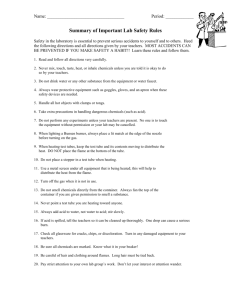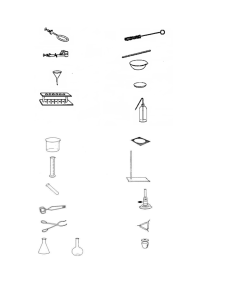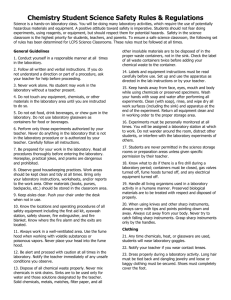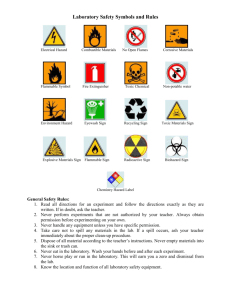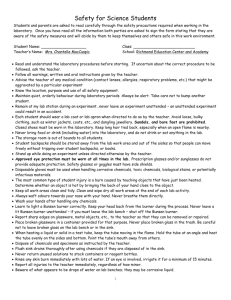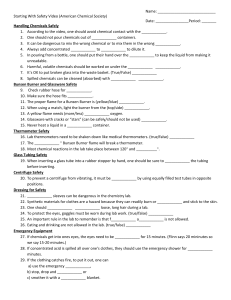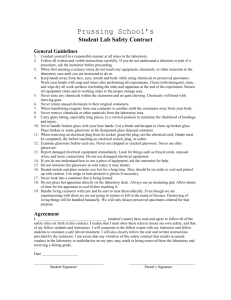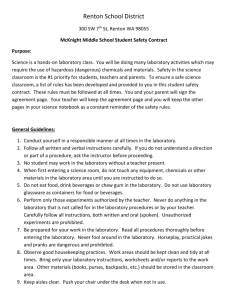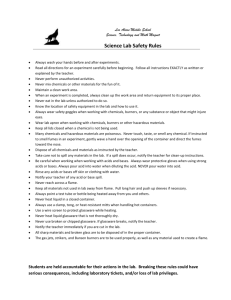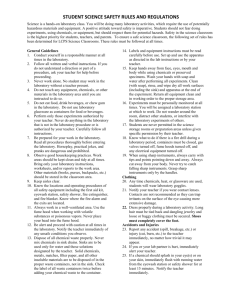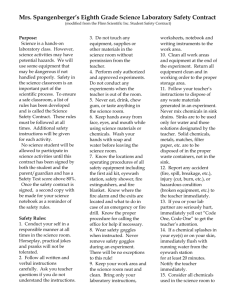safety in the lab
advertisement
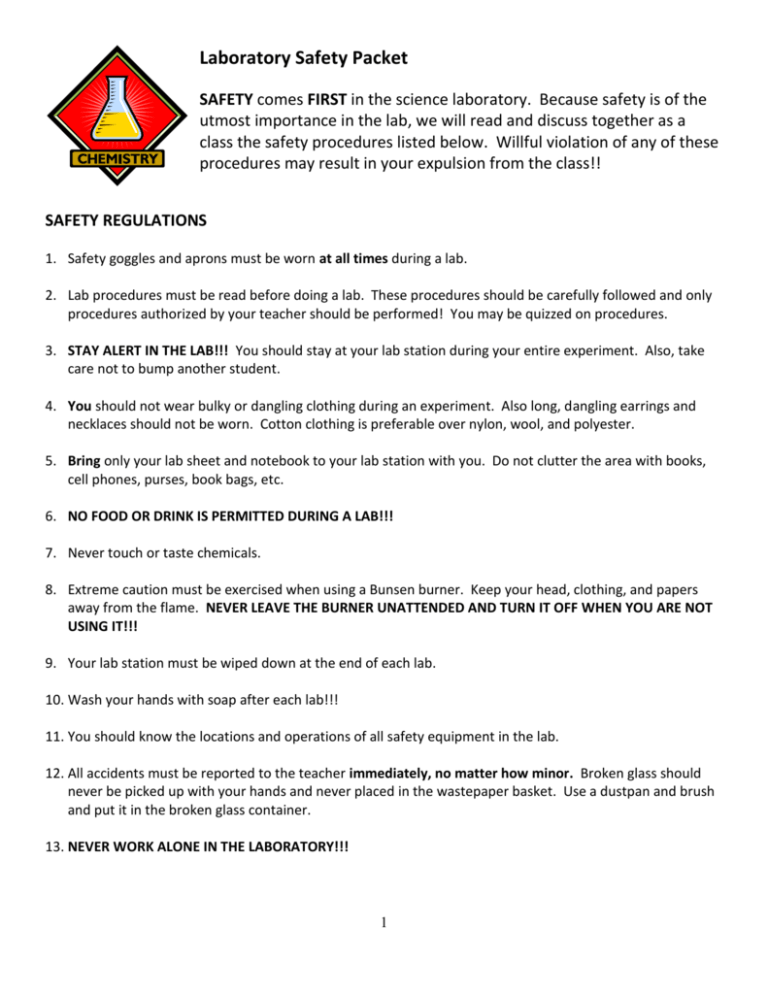
Laboratory Safety Packet SAFETY comes FIRST in the science laboratory. Because safety is of the utmost importance in the lab, we will read and discuss together as a class the safety procedures listed below. Willful violation of any of these procedures may result in your expulsion from the class!! SAFETY REGULATIONS 1. Safety goggles and aprons must be worn at all times during a lab. 2. Lab procedures must be read before doing a lab. These procedures should be carefully followed and only procedures authorized by your teacher should be performed! You may be quizzed on procedures. 3. STAY ALERT IN THE LAB!!! You should stay at your lab station during your entire experiment. Also, take care not to bump another student. 4. You should not wear bulky or dangling clothing during an experiment. Also long, dangling earrings and necklaces should not be worn. Cotton clothing is preferable over nylon, wool, and polyester. 5. Bring only your lab sheet and notebook to your lab station with you. Do not clutter the area with books, cell phones, purses, book bags, etc. 6. NO FOOD OR DRINK IS PERMITTED DURING A LAB!!! 7. Never touch or taste chemicals. 8. Extreme caution must be exercised when using a Bunsen burner. Keep your head, clothing, and papers away from the flame. NEVER LEAVE THE BURNER UNATTENDED AND TURN IT OFF WHEN YOU ARE NOT USING IT!!! 9. Your lab station must be wiped down at the end of each lab. 10. Wash your hands with soap after each lab!!! 11. You should know the locations and operations of all safety equipment in the lab. 12. All accidents must be reported to the teacher immediately, no matter how minor. Broken glass should never be picked up with your hands and never placed in the wastepaper basket. Use a dustpan and brush and put it in the broken glass container. 13. NEVER WORK ALONE IN THE LABORATORY!!! 1 SAFETY IN THE LAB I. II. III. IV. V. VI. VII. Caustic Substances Alert your teacher to any chemical spills. Do not let acids or bases touch your clothing or skin. If a substance gets on your skin, rinse it off with cool water and alert your teacher. NEVER ADD WATER TO ACIDS. ALWAYS ADD ACIDS TO WATER (REMEMBER AAA). When shaking or heating a test tube containing chemicals, never point the mouth of the test tube toward another person. Chemical Safety Never taste any substance in the lab, and do not eat or drink from the glassware. Do not eat or drink in the lab. NEVER RETURN UNUSED CHEMICALS TO THEIR ORIGINAL CONTAINER!!! All bottles and test tubes should be properly labeled. Gas Precaution NEVER INHALE FUMES DIRECTLY!!! If instructed by your teacher to smell a substance, gently wave the fumes toward your nose and inhale gently. (Colored gases are usually poisonous). Always use a fume hood when dealing with dangerous substances. Explosion Danger Never use an open flame when working with flammable liquids like ether or alcohol. Use a safety shield or screen if there is a potential danger of explosion. Eye Safety Wear approved goggles in the lab. Make sure you know the location and operation of the emergency eyewash station. Fire Safety Make sure that you know the locations and operations of the fire blanket and fire extinguisher. Tie back long hair and confine loose clothing. Wear safety goggles when working with flames. Never reach across an open flame. Heating Safety Use proper procedures when lighting your Bunsen burner. Turn off all open flames when not in use. Heat beakers or flasks with wire gauze between the glass and the flame. Turn off the gas valves when not in use. Do not put hot equipment back into your lab drawer! 2 VIII. IX. X. Proper Waste Disposal Clean up all material when you finish a lab. Follow your teacher’s directions regarding disposal of all chemicals. Place broken glass in a specially designed container. Glassware Safety Check the condition of glassware before and after each lab. Inform your teacher of any broken, chipped, or cracked glassware. Air dry glassware. DO NOT PICK UP BROKEN GLASSWARE WITH YOUR HANDS!!! Use a dustpan and brush. Never place glassware near the edges of your lab table. Hand Safety Use tongs when handling test tubes. Allow heated materials to cool before handling them. SPECIAL INFORMATION REGARDING SAFETY CONTROL EQUIPMENT EYEWASH STATION This is designed to reduce injuries from chemicals splashed near the eyes. Affected areas should be washed for at least 15 minutes. SAFETY SHOWER These are designed to reduce injuries from acid burns, toxic chemicals, or clothing fires. It should be used for approximately 15 seconds. FIRE BLANKETS These are used to smother flaming hair or clothing. If the clothing is polyester, use the safety shower to put out the fire. FIRE EXTINGUISHERS The fire extinguisher is labeled to indicate which of the four classes of fires which they can be used to extinguish. Be aware of this. EMERGENCY GAS SHUT-OFF In the event of an emergency, the gas and electricity to the wall outlets can be shut off by pressing the red button behind my lab table. TELEPHONE In the event of an emergency, pick up the phone and press the emergency button. This will reach the main office, nurse, and administrators. Describe the situation and they will call 911. 3 4 Equipment: You must be able to identify the equipment and know their uses. Beaker – Used as a container like a cup. May be heated. Bunsen Burner – Used to heat chemicals in beakers or test tubes. Crucible – Used to heat small amounts of solid material at high temperature. Erlenmeyer Flask – Used to hold/mix liquids. May be heated. Evaporating Dish – Used as a container for small amounts of liquid to be evaporated. Florence Flask – Used to hold/mix liquids. May be heated. Funnel – Used to hold filter paper or for pouring. Graduated Cylinder – Used to measure volume. Pipestem Triangle – Used to support the crucible. Ring – Used to fasten to the ring stand as a support for apparatus. Ring Stand – Used to support apparatus. Scoopula – Used to transfer larger quantities of chemicals for massing. Spatula – Used to transfer smaller quantities of solid chemicals for massing. Test Tube – Used to hold/mix chemicals. Many other uses. May be heated. Test Tube Brush – Used to scrub glass apparatus. Test Tube Clamp – Used to hold apparatus. May be fastened to the ring stand. Test Tube Holder – Used to hold test tubes with your hand. Test Tube Rack – Used to hold test tubes in an upright position. Tongs – Used to pick up and hold apparatus. Wash Bottle – Used to dispense distilled water. Watch Glass – May be used as a cover for an evaporating dish or beaker or to evaporate very small amounts of water. Wire Gauze/Burner Screen – Used to spread the heat of a flame. 5
